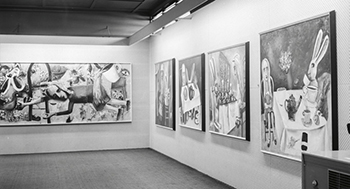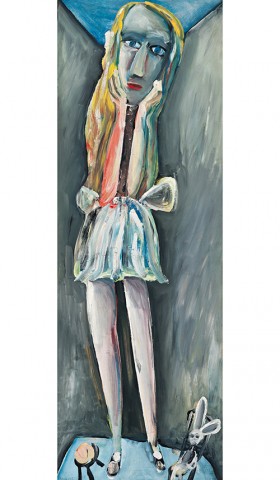ALICE TALL, 1956
CHARLES BLACKMAN
tempera and oil on composition board
121.5 x 41.5 cm
signed lower left: BLACKMAN
bears inscription verso: J Gallery / … / 34
Barbara Blackman, Melbourne, a gift from the artist in 1957
Lauraine Diggins Gallery, Melbourne (label attached verso)
Private collection, Melbourne, acquired from the above in 1984
probably: Paintings from Alice in Wonderland, Gallery of Contemporary Art, Melbourne, 12 – 22 February 1957
‘Alice in Wonderland’ by Charles Blackman, Johnstone Gallery, Brisbane, 4 – 21 September 1966, cat. 22
‘Alice in Wonderland’ by Charles Blackman, South Yarra Gallery, Melbourne, 21 – 30 March 1967, cat. 29
Charles Blackman ‘Alice in Wonderland’, David Jones’ Art Gallery, Sydney, 14 – 26 October 1968, cat. 34
‘Alice in Wonderland’ painted in 1956-57 by Charles Blackman, Heide Park and Art Gallery, Victoria, 24 May – 10 July 1983, cat. 31
Lauraine Diggins Gallery, Melbourne, October – November 1984, cat. 37 (as ‘Tall Alice’)
Innocence and Danger: An Artist’s View of Childhood, Heide Park and Art Gallery, Victoria, 6 June – 19 July 1987, cat. 19
Charles Blackman: Alice in Wonderland, National Gallery of Victoria, Melbourne, 11 August – 15 October 2006, cat. 22
Shapcott, T., Focus on Charles Blackman, University of Queensland Press, Brisbane, 1967, pp. 31 (illus.), 34
Amadio, N., Charles Blackman: The Lost Domains, A.H. & A.W. Reed, Sydney, 1980, pp. 22 (illus.), 24, 142
Carroll, L., Alice’s Adventures in Wonderland: Illustrated by Charles Blackman, A.H. & A.W. Reed, Sydney, 1982, p. 120 (illus.)
Holloway, M., ‘Blackman’s World of Alice a Delight’, The Age, Melbourne, 8 June 1983, p. 14 (illus.)
Smith, G., and Moore, F. St. J., Charles Blackman: Alice in Wonderland, exhibition catalogue, National Gallery of Victoria, Melbourne, 2006, pp. 21, 82, 83 (illus.), 137
Just at this moment her head struck against the roof of the hall: in fact she was now rather more than nine feet high, and she at once took up the little golden key and hurried off to the garden door. Poor Alice! It was as much as she could do, lying down on one side, to look through into the garden; but to get through was more hopeless than ever: she sat down and began to cry again.
‘You ought to be ashamed of yourself’, said Alice, ‘a great girl like you’ (she might well say this), ‘to go on crying in this way! Stop this moment, I tell you!’ But she went on all the same, shedding gallons of tears, until there was a great pool all round her, about four inches deep and reaching half down the hall.’1
Of all Charles Blackman’s myriad achievements, none have captured the public imagination more powerfully than his images inspired by Lewis Carroll’s Alice’s Adventures in Wonderland. Simultaneously amusing and quietly disturbing, these boldly coloured, lyrical depictions of Carroll’s absurd tale not only encapsulate the duality that is a hallmark of Blackman’s oeuvre – innocence and experience, fantasy and fact, dream and nightmare. More poignantly perhaps, the series also reveals the existential, often strongly autobiographical nature of Blackman’s art, offering valuable insight both into his own inner world, and the human condition more universally. As Thomas Shapcott suggests, Alice was the subject that ‘[released] in Blackman the artist the imaginative capacity to explore freely, without the worry of strict realism or logic, that world of experience, of feeling, which exists in all of us’.2
Growing up in a house devoid of books, remarkably Blackman had never encountered Carroll’s famous masterpiece until 1956 when, listening to an audiobook of Alice’s adventures that his wife Barbara (who was legally blind) had borrowed from the library, he was immediately struck by unmistakable parallels between the protagonist’s fantastical experiences and the miraculous process of transformation he was currently witnessing in Barbara with her first pregnancy and increasing blindness. As Barbara eloquently described Alice (but could equally have been writing of herself), ‘…moving enquiringly, questioningly, trustfully, bemusedly, changefully, into a new and strange world, trying with good sense and honesty to get her bearings in it, however often she seemed to change body shape and whereabouts’.3
Just as pregnancy had heralded Barbara’s transition from innocence into womanhood, so too it ended her work as a life model, thereby curtailing the earnings that had previously supplemented her pension for the sight-impaired and allowed Blackman the freedom to paint full time. Accordingly, the artist was prompted to find employment as a short-order cook in the Eastbourne Café (better known in its later incarnation as The Balzac Restaurant) in Wellington Parade, East Melbourne. Owned by his friend, European émigré Georges Mora, the bustling restaurant significantly afforded not only a source of income, but a rich repertoire of motifs for his Alice in Wonderland series. As Blackman later recalled, ‘I went to work … at 5pm … and … finished at 12 and then came home and my head was full of spinning plates and teacups, and Barbara would say I brought the rabbit into the restaurant at night and it would help me to do the work, and next day l would paint it all. The restaurant came into the paintings’.4
Blackman.jpg

A soulful example from the celebrated series, Alice Tall, 1956 features the protagonist occupying the full height of the composition’s vertical format, squeezed in a tight pictorial corner, her head off-centre, wedged between her yellow hair, grey weeping walls, sloping ceiling and slipping floor. Despite the comic nature of her predicament, Blackman presents her bearing a serious face with tears, represented by the creamy brushstrokes, streaming down her arms and hair into her gushing skirt. Notably reminiscent of the starched pinnies worn by restaurant waitresses, the full apron here perhaps offers a whimsical play on the notion of ‘waiting’, while her tears no doubt also bear allusion to the ‘real’ Alice (Barbara) and her predisposition to crying during her pregnancy.5 Portraying tangibly the tender vulnerability of a little girl’s growing mind – her fantasies and fears, her romantic spirit and sense of humour, the mystery and beauty of her days of wonder – thus Blackman evokes, as Nadine Amadio elucidates, ‘memory of those bursting explosions of childhood when reality and imagination become so entangled they burst at the seams … to shoot up like the tallest adult or close down like the tiniest child – to remember the anguish and joy at the sheer size of the world…’.6
Although the inaugural exhibition of the Alice paintings at the Gallery of Contemporary Art, Melbourne in February 1957 was far from a commercial success, within the decade critics had begun to appreciate more fully Blackman’s unique vision. Today, the series remains one of the most highly acclaimed in the canon of Australian art, with examples held in most major private and public collections around the country. Highlighting the enduring power of Blackman’s legacy, indeed Gertrude Langer astutely observed at the opening of the artist’s ‘Alice in Wonderland’ show at the Johnstone Gallery, Brisbane in 1966,
‘… I feel certain these paintings will live when much that is now fashionable is forgotten … One is transported into a world of magic … The intensity and articulateness of Blackman’s poetical feeling and imagination are matched, equally by his resources as a painter. The bold, as well as sensitive and expressive structure of his works, the luminosity and intensity of his colours and their rare juxtapositions and harmonies, the freshness with which the colours are put down ...’7
1. Carroll, L., ‘The Pool of Tears’, Alice’s Adventures in Wonderland, Macmillan and Co., London, 1866, pp. 17 – 18
2. Shapcott, T., The Art of Charles Blackman, Andre Deutsch, London, 1989, p. 30
3. Barbara Blackman quoted in St John Moore, F. & Smith, G., Charles Blackman: Alice in Wonderland, exhibition catalogue, National Gallery of Victoria, Melbourne, 2006, p. 4
4. The artist quoted in Shapcott, op. cit., 1989, p. 23
5. St John Moore & Smith, 2006, op. cit., p. 82
6. Amadio, N., Charles Blackman: The Lost Domains, A.H. & A.W. Reed, Sydney, 1980, pp. 24, 29
7. Langer, G., ‘Blackman’s Genius in his ‘Alice’ Series’, Courier Mail, Brisbane, 7 September 1966, p. 2
VERONICA ANGELATOS
